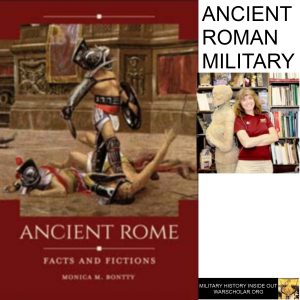Podcast: Play in new window | Download
Subscribe: RSS
 Check out this book here https://amzn.to/2B0MNTC
Check out this book here https://amzn.to/2B0MNTC
Dr. Monica Bontty is a professor of archaeological studies and ancient history. She teaches at the University of Louisiana-Monroe and she wrote a book on misconceptions about Ancient Rome. We spoke about the ancient Roman military from the Republic to the Empire and the research she did for the book. (The audio player is at the bottom of the post.)
1:11 – Monica talks about why she wrote a book on misconceptions about Ancient Rome.
2:26 – Monica talks about how the Roman Army changed over time.
5:15 – Monica talks about phalanx style fighting.
6:26 – Monica talks about the maniple system.
7:45 – Monica talks about the reforms of Marius.
10:45 – Monica talks about Julius Caesar and the establishment of the empire.
12:04 – Monica talks about Octavian, Anthony, and Lepidus.
17:00 – Monica talks about military life and benefits.
28:00 – Monica talks about military pride but also the trouble that soldiers got into and abuse of power.
30:22 – Monica talks about military courts.
32:34 – Monica talks about soldier complaints about centurions.
33:10 – Monica talks about where the money came from Rome to hire so many more soldiers during the time of Marius.
34:34 – Monica talks about the abruptness of the reforms of Marius.
35:10 – Monica talks about Hannibal and the Punic Wars.
38:43 – Monica talks about the Praetorian Guard auctioning off the imperial office.
40:56 – Monica talks about where the term barbarian came from.
41:52 – Monica talks about how she researched the book. Livius.org and Penelope are useful resources.
45:21 – Monica talks about the myth of the vomitoria.
48:38 – Monica talks about learning surprising things about Augustus.
50:09 – Monica talks about Nero’s popularity.
51:02 – Monica talks about Roman hygiene.
54:06 – Monica talks about the hygiene standards of the Roman Army and “bad air”.
57:25 – Monica can be found on ulm.edu.
Links of interest
https://products.abc-clio.com/abc-cliocorporate/product.aspx?pc=A5404C
https://webservices.ulm.edu/facultyactivities/profile/bontty
http://penelope.uchicago.edu/Thayer/E/Roman/home.html
For more “Military History Inside Out” please follow me at www.warscholar.org, on Facebook at warscholar, on twitter at Warscholar, on youtube at warscholar1945 and on Instagram @crisalvarezswarscholar. Or subscribe to the podcast on Apple Podcasts | Stitcher | Spotify
Guests: Monica Bontty
Host: Cris Alvarez
Tags: military, history, military history, conflict, war, interview, non-fiction book, Nero, Caligula, Rome, Italy, Roman Army, legio, cavalry, phalanx, maniple, Marius, Julius Caesar, Augustus, military camp, barbarian, Hannibal, Pax Romana, Gauls, Egypt, auxiliary troops, Arminius, proscription, Golden Ass, centurions, Punic Wars, Praetorian Guard, Vomitoria, Nero, Hollywood

